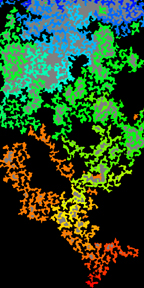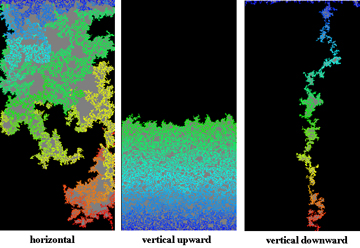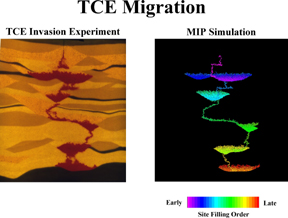
Modified Invasion Percolation (MIP) Model — Wetting fluid flowing into a dry fracture. Blue denotes earliest inflow while red is the latest. Gray represents entrapped air. MIP takes into account the effects of contact angle, local aperture field geometry, and local in-plane interfacial curvature between phases when modeling the invasion of one fluid into another, in a discretized aperture field.
For More Information
Glass, R.J., M.J. Nicholl, and L Yarrington, A modified invasion percolation model for low-capillary number immiscible displacements in horizontal rough-walled fractures: Influence of local in-plane curvature, Water Resources Research, 34:12:3215-3234, 1998. (plus a correction in 2000)

Three images generated from a MIP model show the effect of gravity on fluid moving through a fracture. In a vertical fracture a liquid traveling downward with gravity froms a thin finger. Moving upward the liquid will uniformly fill the fracture except for entrapped air.
For More Information
Glass, R.J., and L. Yarrington, Simulation of gravity-driven fingering in porous media using a modified invasion percolation model, Geoderma, 70:231-252, 1996.

A comparison between experimental data and MIP. Red dyed TCE was injected into a water-saturated, macro-heterogeneous sand pack. The model used a discretized image of the sand pack overlain with a randomized pore network which matched the bulk sand characteristics.
For More Information
Glass, R.J., S.H. Conrad, and L. Yarrington, Gravity destabilized non-wetting phase invasion in macroheterogeneous porous media: Near pore scale macro modified invasion percolation model, Water Resources Research, 37:5:1197-1207, 2001.